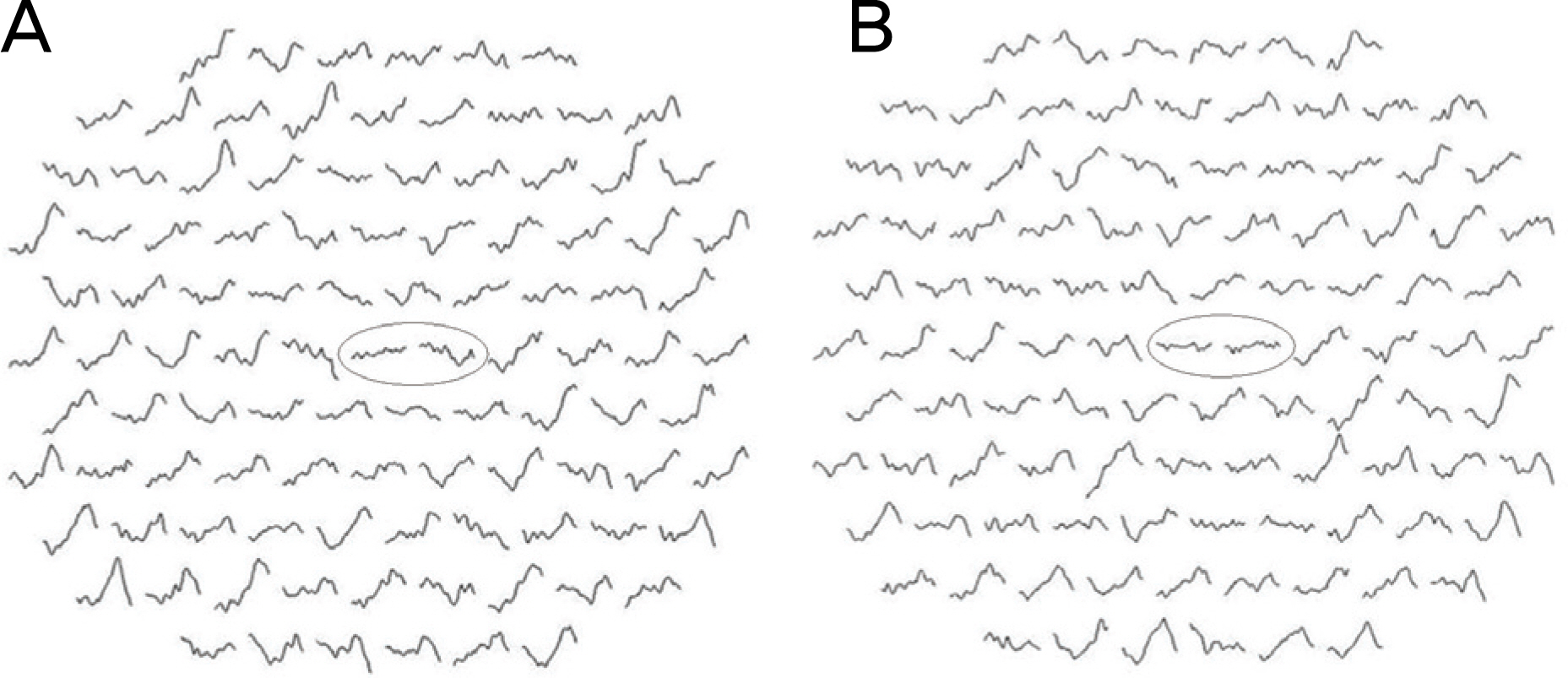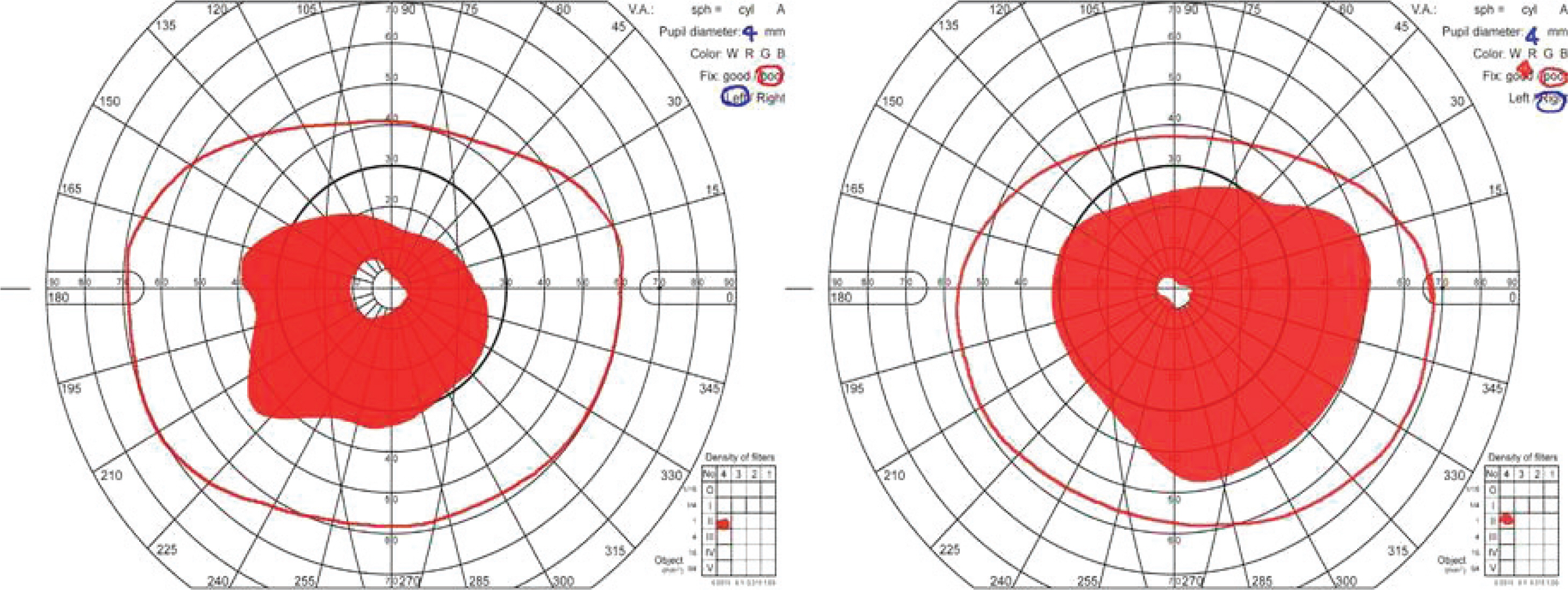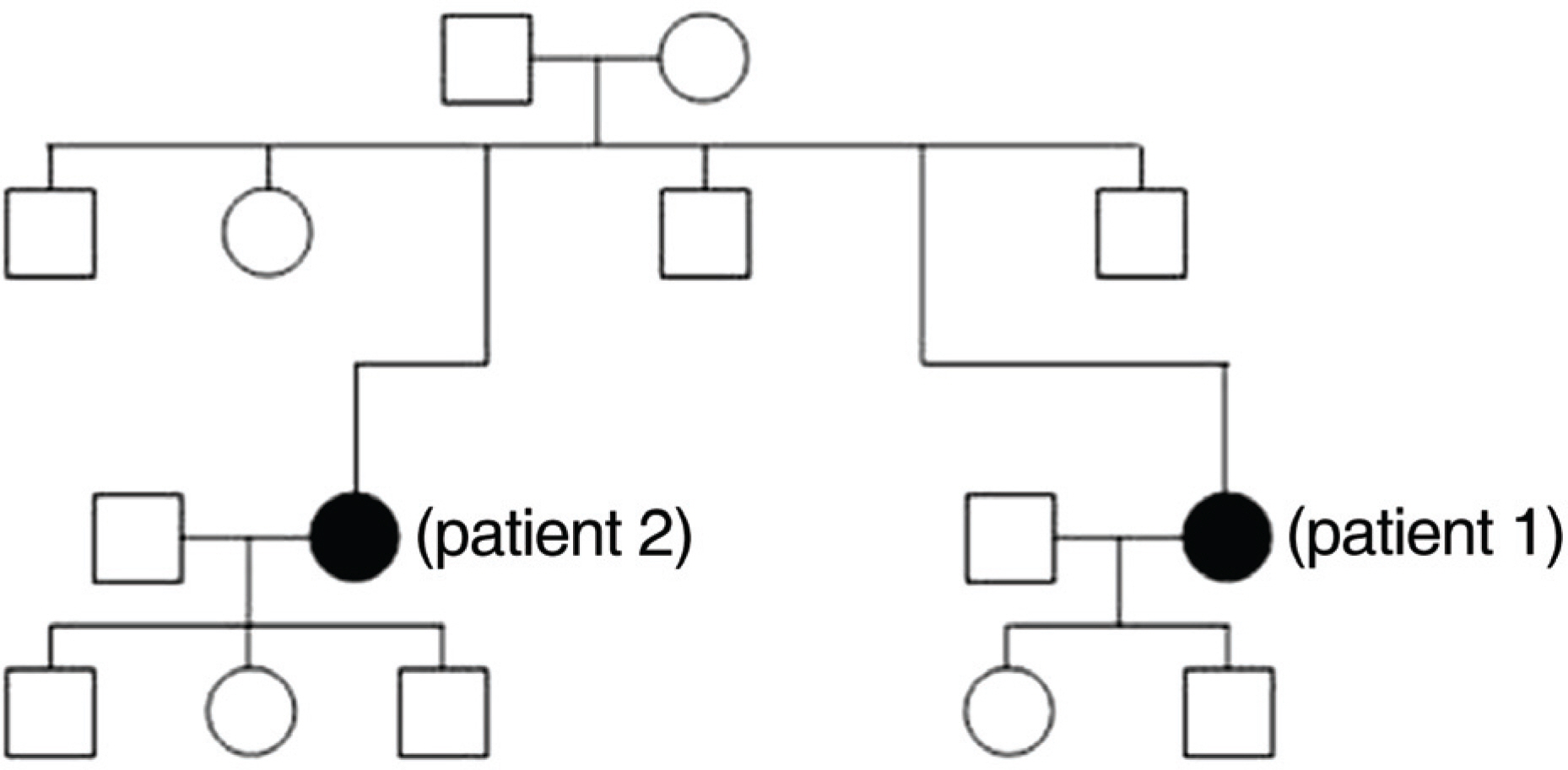J Korean Ophthalmol Soc.
2009 Jul;50(7):1120-1127. 10.3341/jkos.2009.50.7.1120.
Two Female Siblings With Bietti Crystalline Retinopathy Without Corneal Dystrophy
- Affiliations
-
- 1Department of Ophthalmology, Seoul National University College of Medicine, Seoul, Korea. hgonyu@snu.ac.kr
- 2Sensory Organ Institute, Medical Research Center, Seoul National University, Seoul, Korea.
- KMID: 2212505
- DOI: http://doi.org/10.3341/jkos.2009.50.7.1120
Abstract
- PURPOSE
To report clinical and functional results in two female siblings with Bietti crystalline retinopathy. CASE SUMMARY: Recently, a 48-year-old female with bilateral intraretinal depositions presented with a complaint of decreased visual acuity and night blindness in both eyes. Several tiny glistening yellow intraretinal crystalline depositions were observed. Fluorescein angiography showed a well-demarcated choriocapillaris filling defect and pigment epithelial window defect. Electrophysiologic tests showed decreased amplitude and OCT scans showed fine intraretinal lesions with increased signal intensity. In addition, a 50-year-old female sibling presented with bilateral yellow, intraretinal crystalline depositions. A choriocapillaris filling defect and pigment epithelial window defect in a fluorescein angiography was observed. Electrophysiologic tests showed severely decreased amplitude. CONCLUSIONS: Two female siblings with Bietti crystalline retinopathy are reported.
Keyword
MeSH Terms
Figure
Reference
-
References
1. Bietti GB. Ueber familiares Vorkommen von “Retinitis punctata albescens” (verbunden mit “Dystrophia marginaliscristallinea cornea”): Glitzern des Glaskörpers und anderen degenerativen Augenveränderungen. Klin Monatsbl Augenheilkd. 1937; 99:737–56.2. Bagolini B, Ioli-Spada G. Bietti's tapetoretinal degeneration with marginal corneal dystrophy. Am J Ophthalmol. 1968; 65:53–60.3. Welch RB. Bietti's tapetoretinal degeneration with marginal corneal dystrophy crystalline retinopathy. Trans Am Ophthalmol Soc. 1977; 75:164–79.4. Grizzard WS, Deutman AF, Nijhuis F, de Kerk AA. Crystalline retinopathy. Am J Ophthalmol. 1978; 86:81–8.5. Kaiser-Kupfer MI, Chan CC, Markello TC, et al. Clinical biochemical and pathologic correlations in Bietti's crystalline dystrophy. Am J Ophthalmol. 1994; 118:569–82.
Article6. Hu DN. Ophthalmic genetics in China. Ophthalmic Paediatr Genet. 1983; 2:39–45.
Article7. Lin J, Nishiguchi KM, Nakamura M, et al. Recessive mutations in the CYP4V2 gene in East Asian and Middle Eastern patients with Bietti crystalline corneoretinal dystrophy. J Med Genet. 2005; 42:e38.
Article8. Chan WM, Pang CP, Leung AT, et al. Bietti crystalline retinopathy affecting all 3 male siblings in a family. Arch Ophthalmol. 2000; 118:129–31.9. Bernauer W, Daicker B. Bietti's corneal retinal dystrophy. A 16-year progression. Retina. 1992; 12:18–20.10. Mauldin WM, O'Conner PS. Crystalline retinopathy (Bietti's tapetoretinal degeneration without marginal corneal dystrophy). Am J Ophthalmol. 1981; 92:640–6.
Article11. Richards BW, Brodstein DE, Nussbaum JJ, et al. Autosomal dominant crystalline dystrophy. Ophthalmology. 1991; 98:658–65.
Article12. Miyauchi O, Murayama K, Adachi-Usami E. A family with crystalline retinopathy demonstrating an autosomal dominant inheritance pattern. Retina. 1999; 19:573–4.
Article13. Hahn DK, Park YH. A case of crystalline retinopathy. J Korean Ophthalmol Soc. 1995; 36:142–6.14. Cho HK, Ko SM. A case of crystalline retinopathy. J Korean Ophthalmol Soc. 1997; 38:1628–31.15. Kim HD, Seo MS. Crystalline retinopathy without corneal dystrophy. J Korean Ophthalmol Soc. 2000; 41:1445–50.16. Li A, Jiao X, Munier FL, et al. Bietti crystalline corneoretinal dystrophy is caused by mutations in the novel gene CYP4V2. Am J Hum Genet. 2004; 74:817–26.
Article17. Wada Y, Itabash T, Sato H, et al. Screening for mutations in CYP4V2 gene in Japanese patients with Bietti's crystalline corneoretinal dystrophy. Am J Ophthalmol. 2005; 139:894–9.
Article18. Lee KY, Koh AH, Aung T, et al. Characterization of Bietti crystalline dystrophy patients with CYP4V2 mutations. Invest Ophthalmol Vis Sci. 2005; 46:3812–6.19. Shan M, Dong B, Zhao X, et al. Novel mutations in the CYP4V2 gene associated with Bietti crystalline corneoretinal dystrophy. Mol Vis. 2005; 11:738–43.20. Gekka T, Hayashi T, Takeuchi T, et al. CYP4V2 mutations in two Japanese patients with Bietti's crystalline dystrophy. Ophthalmic Res. 2005; 37:262–9.21. Yoshida A, Nara Y, Takahashi M. Crystalline retinopathy: evaluation of blood-retinal barrier by vitreous fluorophotometry. Jpn J Ophthalmol. 1980; 29:290–300.22. Yagasaki K, Miyake Y. Crystalline retinopathy. Nippon Ganka Gakkai Zasshi. 1986; 90:711–9.23. Takikawa C, Miyake Y, Yagasaki K. Reevaluation of crystalline retinopathy based on corneal findings. Folia Ophthalmol Jpn. 1992; 43:969–78.24. Usui T, Tanimoto N, Takagi M, et al. Rod and cone a-waves in three cases of Bietti crystalline chorioretinal dystrophy. Am J Ophthalmol. 2001; 132:395–402.
Article25. Kretschmann U, Usui T, Ruether K, Zrenner E. Electroretinographic campimetry in a patient with crystalline retinopathy. Ger J Ophthalmol. 1996; 5:399–403.26. Chen H, Zhang M, Huang S, Wu D. Functional and clinical findings in 3 female siblings with crystalline retinopathy. Doc Ophthalmol. 2008; 116:237–43.
Article27. Lai TY, Ng TK, Tam PO, et al. Genotype-phenotype analysis of Bietti's crystalline dystrophy in patients with CYP4V2 mutations. Invest Ophthalmol Vis Sci. 2007; 48:5212–20.
- Full Text Links
- Actions
-
Cited
- CITED
-
- Close
- Share
- Similar articles
-
- A Case of Crystalline Retinopathy
- A Case of Spontaneous Regression of Schnyder's Crystalline Corneal Dystrophy
- Three Cases of Outer Retinal Tubulation in Bietti's Crystalline Dystrophy
- Acetazolamide for Cystoid Macular Oedema in Bietti Crystalline Retinal Dystrophy
- Crystalline Retinopathy without Corneal Dystrophy








